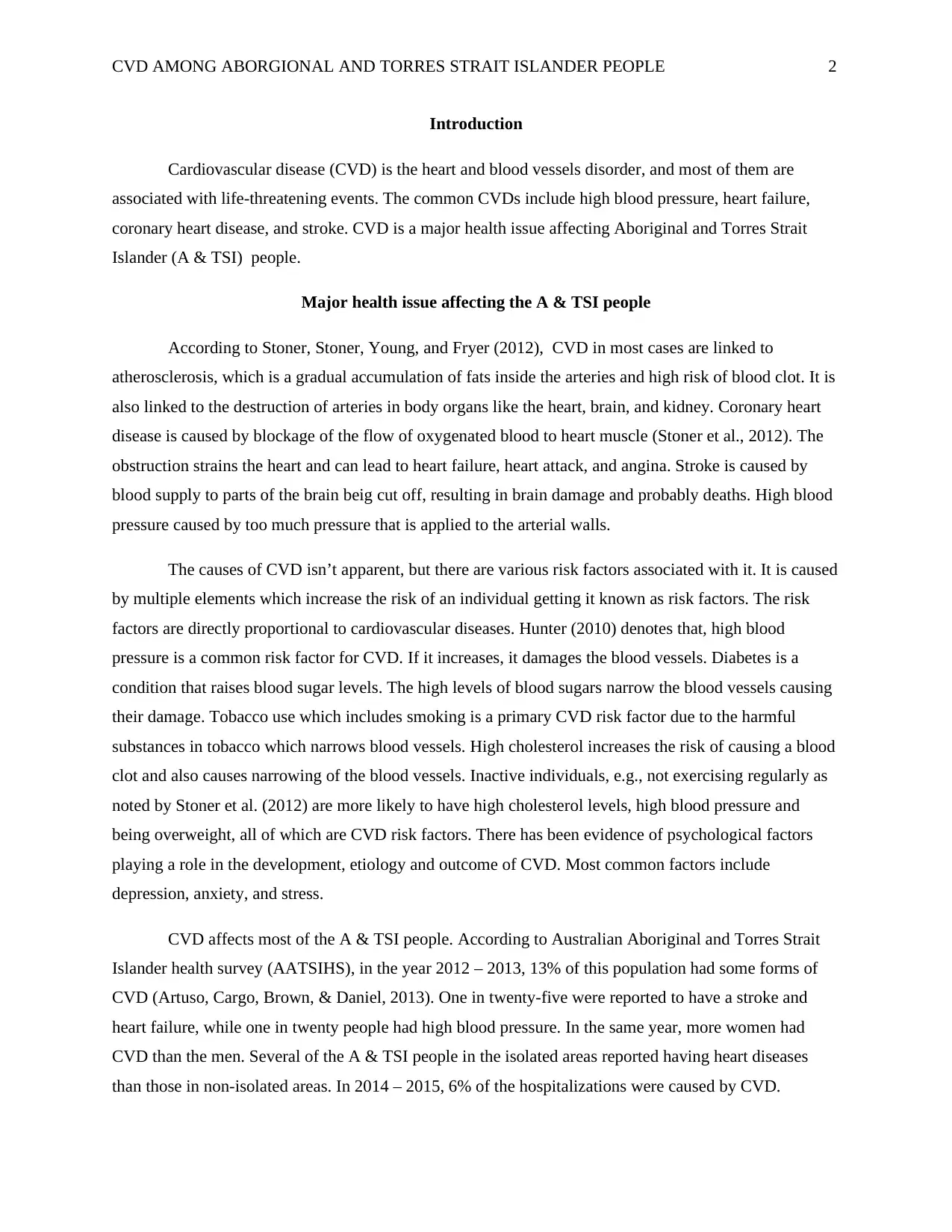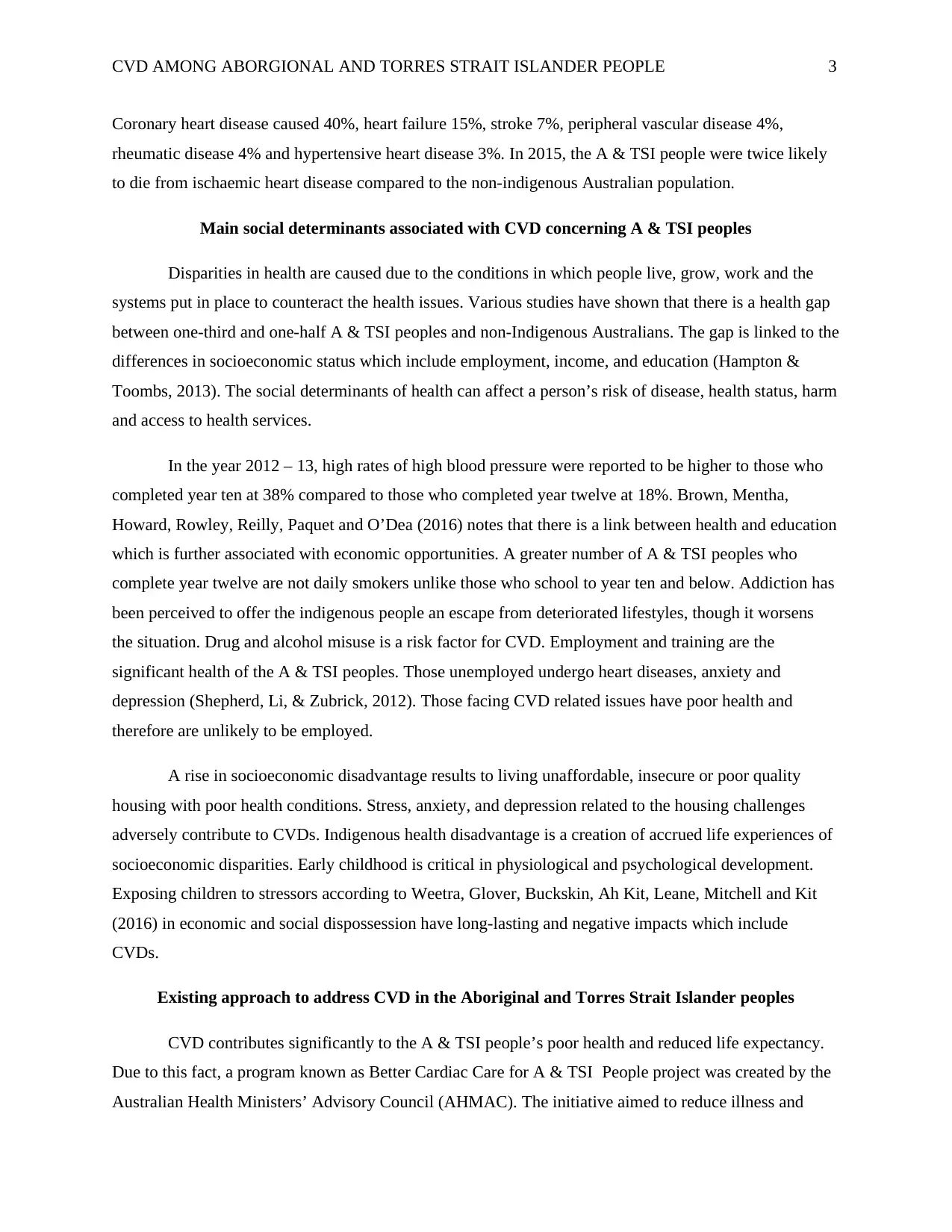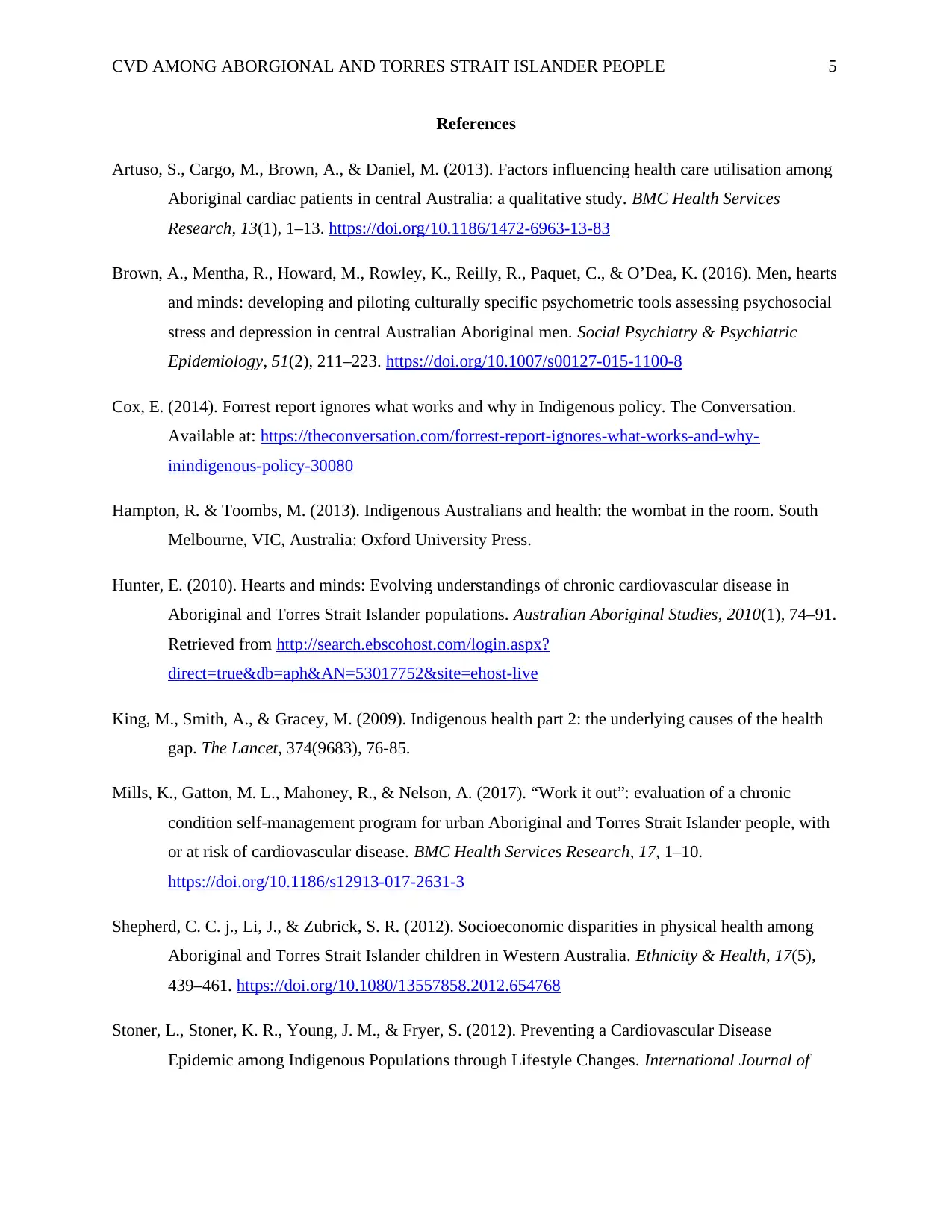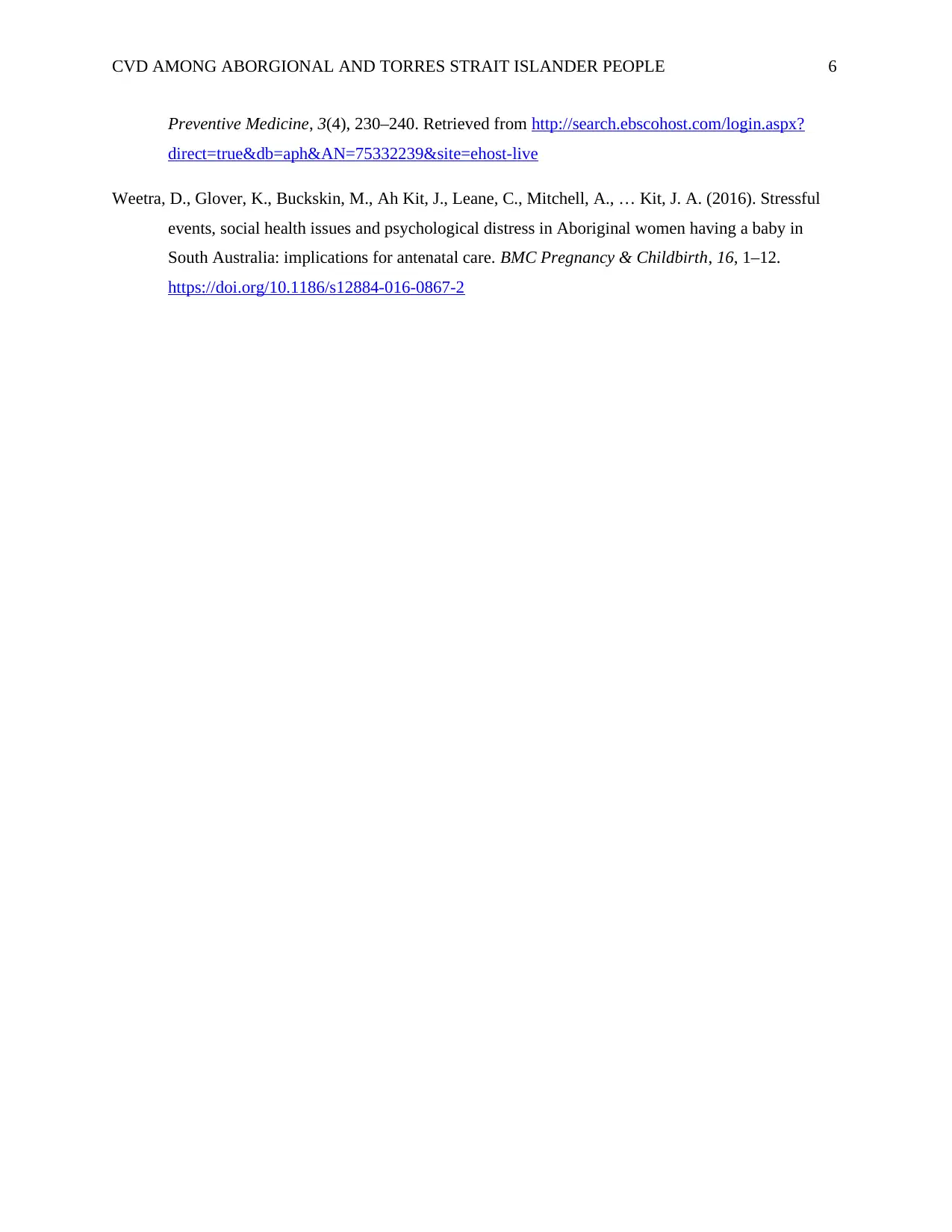Cardiovascular Disease (CVD) Among Aborgional and Torres Strait Islander People
VerifiedAdded on 2023/06/04
|6
|2035
|231
AI Summary
This article discusses the prevalence of cardiovascular disease (CVD) among Aboriginal and Torres Strait Islander (A & TSI) people, the main social determinants associated with CVD concerning A & TSI peoples, and the existing approach to address CVD in the Aboriginal and Torres Strait Islander peoples.
Contribute Materials
Your contribution can guide someone’s learning journey. Share your
documents today.

Running head: CVD AMONG ABORGIONAL AND TORRES STRAIT ISLANDER PEOPLE
Cardiovasular Disease (CVD) Among Aborgional and Torres Strait Islander People
Students’ Name
Affiliate Institution
Cardiovasular Disease (CVD) Among Aborgional and Torres Strait Islander People
Students’ Name
Affiliate Institution
Secure Best Marks with AI Grader
Need help grading? Try our AI Grader for instant feedback on your assignments.

CVD AMONG ABORGIONAL AND TORRES STRAIT ISLANDER PEOPLE 2
Introduction
Cardiovascular disease (CVD) is the heart and blood vessels disorder, and most of them are
associated with life-threatening events. The common CVDs include high blood pressure, heart failure,
coronary heart disease, and stroke. CVD is a major health issue affecting Aboriginal and Torres Strait
Islander (A & TSI) people.
Major health issue affecting the A & TSI people
According to Stoner, Stoner, Young, and Fryer (2012), CVD in most cases are linked to
atherosclerosis, which is a gradual accumulation of fats inside the arteries and high risk of blood clot. It is
also linked to the destruction of arteries in body organs like the heart, brain, and kidney. Coronary heart
disease is caused by blockage of the flow of oxygenated blood to heart muscle (Stoner et al., 2012). The
obstruction strains the heart and can lead to heart failure, heart attack, and angina. Stroke is caused by
blood supply to parts of the brain beig cut off, resulting in brain damage and probably deaths. High blood
pressure caused by too much pressure that is applied to the arterial walls.
The causes of CVD isn’t apparent, but there are various risk factors associated with it. It is caused
by multiple elements which increase the risk of an individual getting it known as risk factors. The risk
factors are directly proportional to cardiovascular diseases. Hunter (2010) denotes that, high blood
pressure is a common risk factor for CVD. If it increases, it damages the blood vessels. Diabetes is a
condition that raises blood sugar levels. The high levels of blood sugars narrow the blood vessels causing
their damage. Tobacco use which includes smoking is a primary CVD risk factor due to the harmful
substances in tobacco which narrows blood vessels. High cholesterol increases the risk of causing a blood
clot and also causes narrowing of the blood vessels. Inactive individuals, e.g., not exercising regularly as
noted by Stoner et al. (2012) are more likely to have high cholesterol levels, high blood pressure and
being overweight, all of which are CVD risk factors. There has been evidence of psychological factors
playing a role in the development, etiology and outcome of CVD. Most common factors include
depression, anxiety, and stress.
CVD affects most of the A & TSI people. According to Australian Aboriginal and Torres Strait
Islander health survey (AATSIHS), in the year 2012 – 2013, 13% of this population had some forms of
CVD (Artuso, Cargo, Brown, & Daniel, 2013). One in twenty-five were reported to have a stroke and
heart failure, while one in twenty people had high blood pressure. In the same year, more women had
CVD than the men. Several of the A & TSI people in the isolated areas reported having heart diseases
than those in non-isolated areas. In 2014 – 2015, 6% of the hospitalizations were caused by CVD.
Introduction
Cardiovascular disease (CVD) is the heart and blood vessels disorder, and most of them are
associated with life-threatening events. The common CVDs include high blood pressure, heart failure,
coronary heart disease, and stroke. CVD is a major health issue affecting Aboriginal and Torres Strait
Islander (A & TSI) people.
Major health issue affecting the A & TSI people
According to Stoner, Stoner, Young, and Fryer (2012), CVD in most cases are linked to
atherosclerosis, which is a gradual accumulation of fats inside the arteries and high risk of blood clot. It is
also linked to the destruction of arteries in body organs like the heart, brain, and kidney. Coronary heart
disease is caused by blockage of the flow of oxygenated blood to heart muscle (Stoner et al., 2012). The
obstruction strains the heart and can lead to heart failure, heart attack, and angina. Stroke is caused by
blood supply to parts of the brain beig cut off, resulting in brain damage and probably deaths. High blood
pressure caused by too much pressure that is applied to the arterial walls.
The causes of CVD isn’t apparent, but there are various risk factors associated with it. It is caused
by multiple elements which increase the risk of an individual getting it known as risk factors. The risk
factors are directly proportional to cardiovascular diseases. Hunter (2010) denotes that, high blood
pressure is a common risk factor for CVD. If it increases, it damages the blood vessels. Diabetes is a
condition that raises blood sugar levels. The high levels of blood sugars narrow the blood vessels causing
their damage. Tobacco use which includes smoking is a primary CVD risk factor due to the harmful
substances in tobacco which narrows blood vessels. High cholesterol increases the risk of causing a blood
clot and also causes narrowing of the blood vessels. Inactive individuals, e.g., not exercising regularly as
noted by Stoner et al. (2012) are more likely to have high cholesterol levels, high blood pressure and
being overweight, all of which are CVD risk factors. There has been evidence of psychological factors
playing a role in the development, etiology and outcome of CVD. Most common factors include
depression, anxiety, and stress.
CVD affects most of the A & TSI people. According to Australian Aboriginal and Torres Strait
Islander health survey (AATSIHS), in the year 2012 – 2013, 13% of this population had some forms of
CVD (Artuso, Cargo, Brown, & Daniel, 2013). One in twenty-five were reported to have a stroke and
heart failure, while one in twenty people had high blood pressure. In the same year, more women had
CVD than the men. Several of the A & TSI people in the isolated areas reported having heart diseases
than those in non-isolated areas. In 2014 – 2015, 6% of the hospitalizations were caused by CVD.

CVD AMONG ABORGIONAL AND TORRES STRAIT ISLANDER PEOPLE 3
Coronary heart disease caused 40%, heart failure 15%, stroke 7%, peripheral vascular disease 4%,
rheumatic disease 4% and hypertensive heart disease 3%. In 2015, the A & TSI people were twice likely
to die from ischaemic heart disease compared to the non-indigenous Australian population.
Main social determinants associated with CVD concerning A & TSI peoples
Disparities in health are caused due to the conditions in which people live, grow, work and the
systems put in place to counteract the health issues. Various studies have shown that there is a health gap
between one-third and one-half A & TSI peoples and non-Indigenous Australians. The gap is linked to the
differences in socioeconomic status which include employment, income, and education (Hampton &
Toombs, 2013). The social determinants of health can affect a person’s risk of disease, health status, harm
and access to health services.
In the year 2012 – 13, high rates of high blood pressure were reported to be higher to those who
completed year ten at 38% compared to those who completed year twelve at 18%. Brown, Mentha,
Howard, Rowley, Reilly, Paquet and O’Dea (2016) notes that there is a link between health and education
which is further associated with economic opportunities. A greater number of A & TSI peoples who
complete year twelve are not daily smokers unlike those who school to year ten and below. Addiction has
been perceived to offer the indigenous people an escape from deteriorated lifestyles, though it worsens
the situation. Drug and alcohol misuse is a risk factor for CVD. Employment and training are the
significant health of the A & TSI peoples. Those unemployed undergo heart diseases, anxiety and
depression (Shepherd, Li, & Zubrick, 2012). Those facing CVD related issues have poor health and
therefore are unlikely to be employed.
A rise in socioeconomic disadvantage results to living unaffordable, insecure or poor quality
housing with poor health conditions. Stress, anxiety, and depression related to the housing challenges
adversely contribute to CVDs. Indigenous health disadvantage is a creation of accrued life experiences of
socioeconomic disparities. Early childhood is critical in physiological and psychological development.
Exposing children to stressors according to Weetra, Glover, Buckskin, Ah Kit, Leane, Mitchell and Kit
(2016) in economic and social dispossession have long-lasting and negative impacts which include
CVDs.
Existing approach to address CVD in the Aboriginal and Torres Strait Islander peoples
CVD contributes significantly to the A & TSI people’s poor health and reduced life expectancy.
Due to this fact, a program known as Better Cardiac Care for A & TSI People project was created by the
Australian Health Ministers’ Advisory Council (AHMAC). The initiative aimed to reduce illness and
Coronary heart disease caused 40%, heart failure 15%, stroke 7%, peripheral vascular disease 4%,
rheumatic disease 4% and hypertensive heart disease 3%. In 2015, the A & TSI people were twice likely
to die from ischaemic heart disease compared to the non-indigenous Australian population.
Main social determinants associated with CVD concerning A & TSI peoples
Disparities in health are caused due to the conditions in which people live, grow, work and the
systems put in place to counteract the health issues. Various studies have shown that there is a health gap
between one-third and one-half A & TSI peoples and non-Indigenous Australians. The gap is linked to the
differences in socioeconomic status which include employment, income, and education (Hampton &
Toombs, 2013). The social determinants of health can affect a person’s risk of disease, health status, harm
and access to health services.
In the year 2012 – 13, high rates of high blood pressure were reported to be higher to those who
completed year ten at 38% compared to those who completed year twelve at 18%. Brown, Mentha,
Howard, Rowley, Reilly, Paquet and O’Dea (2016) notes that there is a link between health and education
which is further associated with economic opportunities. A greater number of A & TSI peoples who
complete year twelve are not daily smokers unlike those who school to year ten and below. Addiction has
been perceived to offer the indigenous people an escape from deteriorated lifestyles, though it worsens
the situation. Drug and alcohol misuse is a risk factor for CVD. Employment and training are the
significant health of the A & TSI peoples. Those unemployed undergo heart diseases, anxiety and
depression (Shepherd, Li, & Zubrick, 2012). Those facing CVD related issues have poor health and
therefore are unlikely to be employed.
A rise in socioeconomic disadvantage results to living unaffordable, insecure or poor quality
housing with poor health conditions. Stress, anxiety, and depression related to the housing challenges
adversely contribute to CVDs. Indigenous health disadvantage is a creation of accrued life experiences of
socioeconomic disparities. Early childhood is critical in physiological and psychological development.
Exposing children to stressors according to Weetra, Glover, Buckskin, Ah Kit, Leane, Mitchell and Kit
(2016) in economic and social dispossession have long-lasting and negative impacts which include
CVDs.
Existing approach to address CVD in the Aboriginal and Torres Strait Islander peoples
CVD contributes significantly to the A & TSI people’s poor health and reduced life expectancy.
Due to this fact, a program known as Better Cardiac Care for A & TSI People project was created by the
Australian Health Ministers’ Advisory Council (AHMAC). The initiative aimed to reduce illness and

CVD AMONG ABORGIONAL AND TORRES STRAIT ISLANDER PEOPLE 4
mortality among the indigenous Australian’s. The reduction of morbidity and mortality according to
King, Smith, and Gracey (2013) is accomplished by improving care conditions, managing risk factors and
treating them in a better way and enhancing access to health services.
The approach was developed to enhance primary preventive care which entails early CVDs
assessment and management. It was also created to get Australia aligned with best practices guidelines
nationally and internationally for chronic diseases and cardiac care. It was also informed by the service
standards that are critical for equitable national cardiovascular care (Mills, Gatton, Mahoney, & Nelson,
2017). AHMAC developed the program by identifying five areas of primary concern. Seventeen actions
were recognized, whereby, the Australian government is accountable to one, territory and state
government are responsible for six and the ten all the governments are accountable.
There have been various outcomes achieved through the program. Since 2015, there has been
optimization of health services in the recognition, intermediation, rehabilitation, and management of
patients linked to Aboriginal and Torres Strait Islander especially in Queensland. There have been
cardiology education forums carried out to community staff working with A & TSI. There has also been a
successful cardiology education with about forty participants attending different services through
teleconference or within the community.
The approach used is strength- based due to various stuff that has worked. There has been
involvement of partnerships, shared leadership, and networks which are created by an element of working
together. The government and other agencies have shown interest through AHMAC and varied hospitals
in improving CVDs among the A & TSI people (Cox, 2014). The program shows that there is a
commitment to work with and assist the indigenous people to counteract the CVDs. Cox (2014) notes that
there is a need to have a cooperative relationship between the recipients, funder, and providers of the
services. The decisions made should enhance the indigenous Australian’s knowledge and ambitions.
mortality among the indigenous Australian’s. The reduction of morbidity and mortality according to
King, Smith, and Gracey (2013) is accomplished by improving care conditions, managing risk factors and
treating them in a better way and enhancing access to health services.
The approach was developed to enhance primary preventive care which entails early CVDs
assessment and management. It was also created to get Australia aligned with best practices guidelines
nationally and internationally for chronic diseases and cardiac care. It was also informed by the service
standards that are critical for equitable national cardiovascular care (Mills, Gatton, Mahoney, & Nelson,
2017). AHMAC developed the program by identifying five areas of primary concern. Seventeen actions
were recognized, whereby, the Australian government is accountable to one, territory and state
government are responsible for six and the ten all the governments are accountable.
There have been various outcomes achieved through the program. Since 2015, there has been
optimization of health services in the recognition, intermediation, rehabilitation, and management of
patients linked to Aboriginal and Torres Strait Islander especially in Queensland. There have been
cardiology education forums carried out to community staff working with A & TSI. There has also been a
successful cardiology education with about forty participants attending different services through
teleconference or within the community.
The approach used is strength- based due to various stuff that has worked. There has been
involvement of partnerships, shared leadership, and networks which are created by an element of working
together. The government and other agencies have shown interest through AHMAC and varied hospitals
in improving CVDs among the A & TSI people (Cox, 2014). The program shows that there is a
commitment to work with and assist the indigenous people to counteract the CVDs. Cox (2014) notes that
there is a need to have a cooperative relationship between the recipients, funder, and providers of the
services. The decisions made should enhance the indigenous Australian’s knowledge and ambitions.
Secure Best Marks with AI Grader
Need help grading? Try our AI Grader for instant feedback on your assignments.

CVD AMONG ABORGIONAL AND TORRES STRAIT ISLANDER PEOPLE 5
References
Artuso, S., Cargo, M., Brown, A., & Daniel, M. (2013). Factors influencing health care utilisation among
Aboriginal cardiac patients in central Australia: a qualitative study. BMC Health Services
Research, 13(1), 1–13. https://doi.org/10.1186/1472-6963-13-83
Brown, A., Mentha, R., Howard, M., Rowley, K., Reilly, R., Paquet, C., & O’Dea, K. (2016). Men, hearts
and minds: developing and piloting culturally specific psychometric tools assessing psychosocial
stress and depression in central Australian Aboriginal men. Social Psychiatry & Psychiatric
Epidemiology, 51(2), 211–223. https://doi.org/10.1007/s00127-015-1100-8
Cox, E. (2014). Forrest report ignores what works and why in Indigenous policy. The Conversation.
Available at: https://theconversation.com/forrest-report-ignores-what-works-and-why-
inindigenous-policy-30080
Hampton, R. & Toombs, M. (2013). Indigenous Australians and health: the wombat in the room. South
Melbourne, VIC, Australia: Oxford University Press.
Hunter, E. (2010). Hearts and minds: Evolving understandings of chronic cardiovascular disease in
Aboriginal and Torres Strait Islander populations. Australian Aboriginal Studies, 2010(1), 74–91.
Retrieved from http://search.ebscohost.com/login.aspx?
direct=true&db=aph&AN=53017752&site=ehost-live
King, M., Smith, A., & Gracey, M. (2009). Indigenous health part 2: the underlying causes of the health
gap. The Lancet, 374(9683), 76-85.
Mills, K., Gatton, M. L., Mahoney, R., & Nelson, A. (2017). “Work it out”: evaluation of a chronic
condition self-management program for urban Aboriginal and Torres Strait Islander people, with
or at risk of cardiovascular disease. BMC Health Services Research, 17, 1–10.
https://doi.org/10.1186/s12913-017-2631-3
Shepherd, C. C. j., Li, J., & Zubrick, S. R. (2012). Socioeconomic disparities in physical health among
Aboriginal and Torres Strait Islander children in Western Australia. Ethnicity & Health, 17(5),
439–461. https://doi.org/10.1080/13557858.2012.654768
Stoner, L., Stoner, K. R., Young, J. M., & Fryer, S. (2012). Preventing a Cardiovascular Disease
Epidemic among Indigenous Populations through Lifestyle Changes. International Journal of
References
Artuso, S., Cargo, M., Brown, A., & Daniel, M. (2013). Factors influencing health care utilisation among
Aboriginal cardiac patients in central Australia: a qualitative study. BMC Health Services
Research, 13(1), 1–13. https://doi.org/10.1186/1472-6963-13-83
Brown, A., Mentha, R., Howard, M., Rowley, K., Reilly, R., Paquet, C., & O’Dea, K. (2016). Men, hearts
and minds: developing and piloting culturally specific psychometric tools assessing psychosocial
stress and depression in central Australian Aboriginal men. Social Psychiatry & Psychiatric
Epidemiology, 51(2), 211–223. https://doi.org/10.1007/s00127-015-1100-8
Cox, E. (2014). Forrest report ignores what works and why in Indigenous policy. The Conversation.
Available at: https://theconversation.com/forrest-report-ignores-what-works-and-why-
inindigenous-policy-30080
Hampton, R. & Toombs, M. (2013). Indigenous Australians and health: the wombat in the room. South
Melbourne, VIC, Australia: Oxford University Press.
Hunter, E. (2010). Hearts and minds: Evolving understandings of chronic cardiovascular disease in
Aboriginal and Torres Strait Islander populations. Australian Aboriginal Studies, 2010(1), 74–91.
Retrieved from http://search.ebscohost.com/login.aspx?
direct=true&db=aph&AN=53017752&site=ehost-live
King, M., Smith, A., & Gracey, M. (2009). Indigenous health part 2: the underlying causes of the health
gap. The Lancet, 374(9683), 76-85.
Mills, K., Gatton, M. L., Mahoney, R., & Nelson, A. (2017). “Work it out”: evaluation of a chronic
condition self-management program for urban Aboriginal and Torres Strait Islander people, with
or at risk of cardiovascular disease. BMC Health Services Research, 17, 1–10.
https://doi.org/10.1186/s12913-017-2631-3
Shepherd, C. C. j., Li, J., & Zubrick, S. R. (2012). Socioeconomic disparities in physical health among
Aboriginal and Torres Strait Islander children in Western Australia. Ethnicity & Health, 17(5),
439–461. https://doi.org/10.1080/13557858.2012.654768
Stoner, L., Stoner, K. R., Young, J. M., & Fryer, S. (2012). Preventing a Cardiovascular Disease
Epidemic among Indigenous Populations through Lifestyle Changes. International Journal of

CVD AMONG ABORGIONAL AND TORRES STRAIT ISLANDER PEOPLE 6
Preventive Medicine, 3(4), 230–240. Retrieved from http://search.ebscohost.com/login.aspx?
direct=true&db=aph&AN=75332239&site=ehost-live
Weetra, D., Glover, K., Buckskin, M., Ah Kit, J., Leane, C., Mitchell, A., … Kit, J. A. (2016). Stressful
events, social health issues and psychological distress in Aboriginal women having a baby in
South Australia: implications for antenatal care. BMC Pregnancy & Childbirth, 16, 1–12.
https://doi.org/10.1186/s12884-016-0867-2
Preventive Medicine, 3(4), 230–240. Retrieved from http://search.ebscohost.com/login.aspx?
direct=true&db=aph&AN=75332239&site=ehost-live
Weetra, D., Glover, K., Buckskin, M., Ah Kit, J., Leane, C., Mitchell, A., … Kit, J. A. (2016). Stressful
events, social health issues and psychological distress in Aboriginal women having a baby in
South Australia: implications for antenatal care. BMC Pregnancy & Childbirth, 16, 1–12.
https://doi.org/10.1186/s12884-016-0867-2
1 out of 6
Related Documents
Your All-in-One AI-Powered Toolkit for Academic Success.
+13062052269
info@desklib.com
Available 24*7 on WhatsApp / Email
![[object Object]](/_next/static/media/star-bottom.7253800d.svg)
Unlock your academic potential
© 2024 | Zucol Services PVT LTD | All rights reserved.





